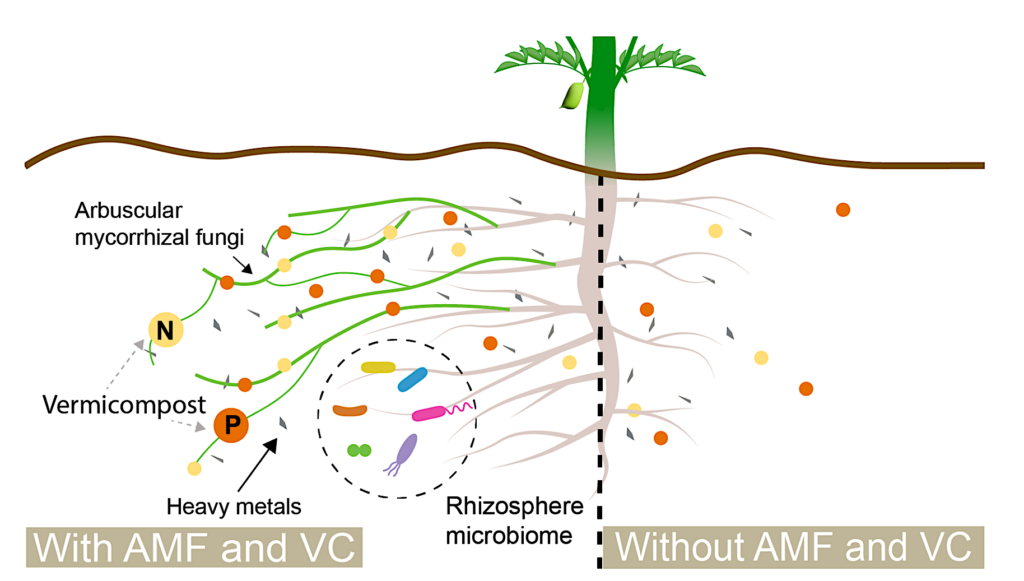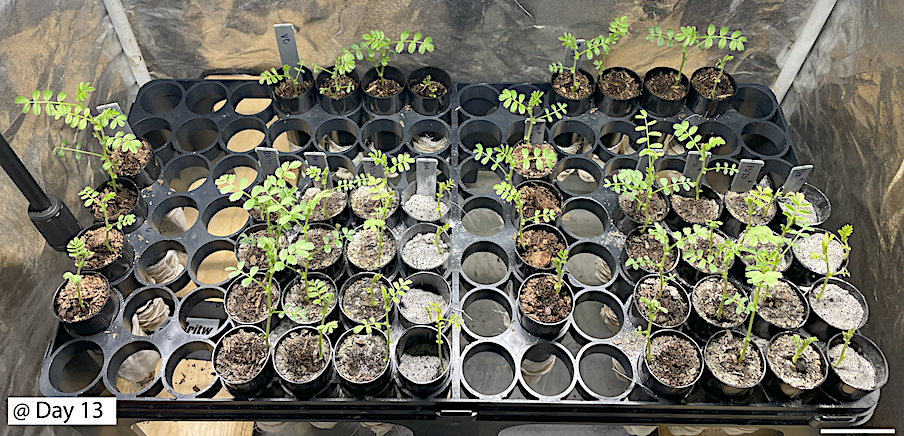
Chickpea flower and seed. Panel a) shows the first flower in AMF-inoculated LRS75, and panel b) shows seeds in AMF-inoculated LRS75.
Food sustainability is one of the most important hurdles for long-duration space travel. Delivering resources from Earth is not cost-effective, and resupply missions are unlikely to meet the needs of long-term life in deep space conditions.
Plants in space can provide a source of nutrients and oxygen, reducing reliance on packaged foods, reducing resupply requirements, and extending the duration of missions. We use a lunar regolith simulant to develop a sustainable and productive growth medium to support cultivation of horticultural crops on the Moon.

Caesar aritenum, AMF and VC in the rhizosphere. 30 cm in chickpea. It has a taproot with lateral root branches. With AMF the root has an extended surface area, reaching otherwise inaccessible nutrients and sequestering heavy metals (HMs) from uptake. An AMF-free root system has less surface area, shorter roots, and fewer defense mechanisms against HMs. — biorxiv.org
By implementing earth-derived microbial soil regeneration processes, we explore interactions between arbuscular mycorrhizal fungi (AMF) and vermicompost (VC) to create a rich LRS matrix. These amendments can sequester toxic contaminants, improve soil structure, and increase plant stress tolerance. We demonstrate the production potential of chickpea (Cicer arietinum) in a lunar regolith simulant augmented with AMF and VC under climate-controlled conditions.

On day 13, there was 100% germination rate. Tests are labeled as in Figure 2. The pot mixture showed larger leaves and more branching, whereas plants in the lunar regolith simulant mixtures showed signs of xenomorphism, with reduced leaf area, reduced leaf growth rate, and shorter shoot height. Additionally, chlorophyll levels are lower in LRS100 (leaf yellowing). — biorxiv.org
We cultivated chickpea from seed in a mixture containing 75% lunar regolith simulant. Preliminary results suggest that higher LRS contents induce greater stress responses. However, plants grown in 100% LRS inoculated with arbuscular mycorrhizal fungi showed an average survival of two weeks compared to non-inoculated plants. This study, for the first time, provides a basis for germinating chickpeas in varying combinations of LRS and VC and will inform future studies when humanity returns to the Moon.
Jessica Atkin, Sarah Oliveira Pedro dos Santos
From Dust to Seed: A Lunar Chickpea Story – Full sheet
Astronomy

„Oddany rozwiązywacz problemów. Przyjazny hipsterom praktykant bekonu. Miłośnik kawy. Nieuleczalny introwertyk. Student.
